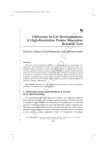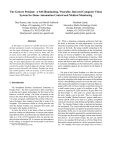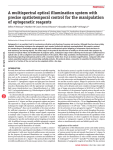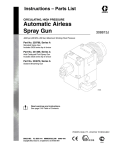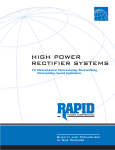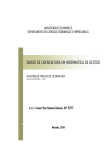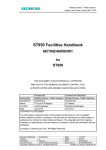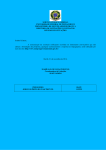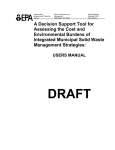Download npgrj_nProt_234 1351..1358
Transcript
PROTOCOL Two-dimensional difference gel electrophoresis Surya Viswanathan1,2, Mustafa Ünlü1,3 & Jonathan S Minden1 1Department of Biological Science, Carnegie Mellon University, Mellon Institute, 4400 Fifth Avenue, Pittsburgh, Pennsylvania 15213, USA. 2Present address: Proteopure Incorporated, 900 William Pitt Way, Pittsburgh, Pennsylvania 15238, USA. 3Present address: Bogazici University, Department of Molecular Biology and Genetics, Bebek, 34342, Istanbul, Turkey. Correspondence should be addressed to J.M. ([email protected]) © 2006 Nature Publishing Group http://www.nature.com/natureprotocols Published online 26 October 2006; doi:10.1038/nprot.2006.234 Two-dimensional difference gel electrophoresis (2D DIGE) is a modified form of 2D electrophoresis (2DE) that allows one to compare two or three protein samples simultaneously on the same gel. The proteins in each sample are covalently tagged with different color fluorescent dyes that are designed to have no effect on the relative migration of proteins during electrophoresis. Proteins that are common to the samples appear as ‘spots’ with a fixed ratio of fluorescent signals, whereas proteins that differ between the samples have different fluorescence ratios. With the appropriate imaging system, DIGE is capable of reliably detecting as little as 0.5 fmol of protein, and protein differences down to ± 15%, over a 410,000-fold protein concentration range. DIGE combined with digital image analysis therefore greatly improves the statistical assessment of proteome variation. Here we describe a protocol for conducting DIGE experiments, which takes 2–3 d to complete. INTRODUCTION The central goals of proteomics include identifying protein changes that differentiate normal and diseased states in cells, tissues or organisms, and examining how protein changes correlate with developmental age and environment. The first stage in comparative proteomics is to separate complex mixtures of protein into individual components; this is typically done using gel electrophoresis (at the whole protein level) or column chromatography (at the peptide level). Both of these separation schemes have advantages and disadvantages. We have focused on two-dimensional electrophoresis (2DE) because of its accessibility to most laboratories. This approach was described simultaneously by several groups in 1975 (refs. 1–3). Despite the substantial advances in the technology since its launch — the most notable of which was the introduction of immobilized pH gradients in the first dimension4,5 — some of the more significant systemic shortcomings have remained unsolved. The most troublesome of these is the inherent lack of reproducibility between gels. Efforts to surmount this limitation have mostly focused on developing computational methods for gel matching. These approaches have had limited success because the sources of gel-to-gel variation are numerous, complex and difficult to model. Difference gel electrophoresis (DIGE) was developed to overcome the irreproducibility problem in the 2DE methodology by labeling two samples each with a different fluorescent dye prior to running them on the same gel (Fig. 1)6. The fluorescent dyes used in DIGE, Cy3-NHS and Cy5-NHS (Fig. 2), are cyanine based, molecular-weight matched, amine reactive and positively charged. These characteristics, coupled with substoichiometric labeling, result in no electrophoretic mobility shifts arising between the two differentially labeled samples when they are co-electrophoresed. Therefore, in DIGE, every identical protein in one sample superimposes with its differentially labeled counterpart in the other sample, allowing for more reproducible and facile detection of differences. Furthermore, DIGE is a sensitive technique, capable of detecting as little as 0.5 fmol of protein, and this detection system is linear over a 410,000-fold concentration range6–8. The most important considerations in performing DIGE experiments are experimental design and sample preparation9. DIGE has been used to analyze proteome changes from a wide variety of cell types and bodily fluids, including serum7,10–12. The sample-preparation protocol depends on the cell type. Most samples require mild homogenization in lysis buffer to extract protein. DIGE is an extremely sensitive method, in which a 15% change in protein abundance is more than two standard deviations (SDs) above the normal variation8. One must take great care in deciding which samples to compare, while bearing in mind the sources of variation. If specific tissues are to be compared, one must carefully dissect Test cells Control cells A B Prepare protein extracts Label with Cy3-NHS Label with Cy5-NHS Mix samples and run on 2D-PAGE Image with fluorescence gel imager MWt pl Figure 1 | Schematic of DIGE analysis. Extracts are made of two cell samples, denoted ‘A’ and ‘B’. These extracts are separately labeled with Cy3-NHS and Cy5-NHS, which covalently link to lysine residues. A low stoichiometry of labeling is used, where B5% of all proteins carry a single dye molecule. The labeled protein extracts are then combined and co-electrophoresed on a 2DE gel. The gel is then imaged on a fluorescent gel imager at the Cy3 and Cy5 wavelengths. MWt, molecular weight; pI, isoelectric point. NATURE PROTOCOLS | VOL.1 NO.3 | 2006 | 1351 PROTOCOL N+ N N+ (CH2)4 (CH2)2 (CH2)4 CO2R CH3 CO2R Cy3 N CH3 Cy5 R = NHS © 2006 Nature Publishing Group http://www.nature.com/natureprotocols Figure 2 | Chemical structure of DIGE dyes. Propyl-Cy3-NHS and methyl-Cy5NHS are shown here. These compounds are charge and mass matched. The fluorescent characteristics of Cy3 and Cy5 are dictated by the three-carbon and five-carbon polyene chains, respectively, linking the two indoline rings. the tissue to avoid variation. Hypothetically, if one has 10% contamination of neighboring tissue in one sample and 5% variation in another, it might lead to artifactual protein differences. One way to avoid tissue contamination is to use laser microdissection, which provides a precise method for capturing specific populations of cells13–15. Another source of variation can arise during sample clean-up or fractionation. If sample clean-up or fractionation is planned, it is best to label the samples independently and then combine them prior to cleanup or fractionation. This will alleviate variation due to handling. Simply measuring total protein after sample cleanup or fractionation will not guard against variation in loss of specific proteins during processing. The protocol described here outlines the steps we use in performing 2D DIGE experiments. We typically use a two-dye approach with Cy3 and Cy5. For comparing model systems, such as Drosophila or yeast, the two-dye approach is more reproducible than the three-dye method, which utilizes a Cy2-labeled pooled sample for normalization16. The three-dye method is better suited to multiple sample comparisons where there is considerable genetic variation, as in the analysis of human samples17. The precursor to the three-dye method was a two-dye method comparing a Cy3-labeled pooled control + test sample and Cy5labeled control or test samples18. We always run two gels for each comparison, in which the order of labeling is reversed (referred to as reciprocal labeling). This allows one to differentiate between sample-dependent differences and rare dye-dependent differences. The latter are presumably due to incomplete solubilization of proteins allowing the two dyes to associate differently with the protein. Loading equal amounts of each protein sample is advisable, but high precision is not required as slight load differences are normalized during image analysis. All steps should be performed on ice or in a cold room if necessary. As soon as lysis is complete, samples can be stored at –80 1C in aliquots of 100–250 mg at concentrations 41 mg ml–1. When comparing whole-cell extracts, we generally load 80–200 mg of each sample (160–400 mg total protein). High-quality digital imaging of DIGE gels is essential for detecting proteome changes. To peer as deeply into the proteome as possible, it is important to use an imager that is capable of true 16-bit data collection. Fluorescent gel imagers come in two formats; scanner-based or CCD camera-based. There are several commercial gel imagers, such as the Typhoon imager (Amersham Biosciences/GE Healthcare), which is commonly used for DIGE gel imaging. The Typhoon imager is based on a scanning laser-illumination system and photomultiplier detector. The 1352 | VOL.1 NO.3 | 2006 | NATURE PROTOCOLS gel-scanning systems that are suitable for DIGE analysis require a different device for spot picking. We use a homemade CCD-based fluorescence imager that has an integrated spot-picking robot (Fig. 3). The main issue to consider in gel imaging is that one should try to utilize the full dynamic range of the detector. The dynamic range of the detector is measured in terms of the number of discrete grey levels or bits of information that each pixel can accommodate. The CCD camera in our imager has a 16-bit dynamic range or 65,536 grey levels. Ideally, one would like to load enough fluorescentlylabeled protein and set the exposure parameters so that the brightest protein spot nearly saturates the full dynamic range of the detector. Another important issue is the fluorescent background. Many of the materials and substances that are placed in the imager can have intrinsic fluorescence. For example, borosilicate glass is highly fluorescent so any glass used to hold the gels in the imager must be made of quartz or fused silica. Although background fluorescent signals can be removed computationally, they limit the dynamic range of the gel images and mask signals from lowabundance proteins. Our gel-imaging system is capable of detecting as little as 0.5 fmol of protein, and can detect proteins over a 410,000-fold concentration range. As there are a limited number of such gel-imaging systems currently in use, we will not describe our imaging protocol here in detail. Image analysis in our laboratory is done using several software applications, including IPLab (Scanalytics), QuickTime and SExtractor. There are integrated image-analysis packages for DIGE gels, the most commonly used of which is DeCyder (Amersham Biosciences/GE Healthcare). We use IPLab and QuickTime for image visualization and annotation. SExtractor is an astrophysics freeware application that has been adapted to quantify protein-spot intensities and ratios (https://sourceforge.net/projects/sextractor)19. Although these separate applications are more time consuming than the commercial packages, we find the analysis to be as reliable CCD camera Gel-cutter stage Stepping motor Cutting tip 96-well plate Gel Stage platform Light-tight cabinet Y-axis stage X-axis stage Figure 3 | Fluorescence gel imager/spot picker. This diagram illustrates the components of the DIGE gel imager. This device comprises the following components: a scientific-grade Peltier-cooled 16-bit CCD camera (Photometrics/Roper Scientific); an 105-mm macro lens (Nikon); a computerdriven stage (New England Affiliated Technology); and a spot-picker drive (Applied Precision). All electronic components are controlled by a computer workstation running Windows and custom software. Not shown is the illumination system, which is composed of two 250 W quartz-tungstenhalogen light sources (Oriel) that direct their light through motorized filter wheels (Ludl). The light is directed onto the gel via fiber-optic light guides (Oriel), and fluorescence wavelengths are selected by band-pass filters (Chroma Technology). © 2006 Nature Publishing Group http://www.nature.com/natureprotocols PROTOCOL as that achieved with DeCyder. None of the current image-analysis applications are completely automatic in that the computer determines which protein spots are changing and the degree of change. A certain amount of editing of the detected spots by visual inspection is required. We find that visual inspection of a two-frame looping movie of the Cy3 and Cy5 gel images is the most reliable method for detecting protein differences and for spot-list editing. For visual inspection, we find that two-frame looping movies are much more robust than superimposing two pseudocolor images of Cy3-labeled and Cy5-labeled proteins. While state-of-the-art, automated spot-detection applications are becoming more robust, visual inspection is still used as the final arbiter. The outcome of image analysis is a list of differenceprotein spots that indicate putative differentially expressed or modified candidate proteins. This spot list can be used for large-scale protein-profiling studies using standard bioinformatics tools20. Despite DIGE being sensitive and reproducible, three caveats need to be mentioned. First, 2DE does not efficiently resolve integral membrane proteins. This is due to their hydrophobic MATERIALS REAGENTS m CRITICAL Use double-distilled H2O unless otherwise stated m CRITICAL The source and purity of ingredients is critical, especially for solutions used for labeling and IEF . Urea (Bio-Rad) . Thiourea (Sigma) . CHAPS (Roche) . DTT (Sigma) . SDS (20% stock solution; Bio-Rad) . HEPES (100 mM Na-HEPES, pH 8.0, stock; Sigma) . Cy3-NHS (Amersham Biosciences/GE Healthcare) . Cy5-NHS (Amersham Biosciences/GE Healthcare) . Protein clean-up kit (e.g., ProteoHookt; Proteopure) . Iodoacetamide (Sigma) . Acrylamide (30% T, 2.6% C stock solution; Bio-Rad) . N,N,N¢,N¢-tetramethylethylenediamine (TEMED; Sigma) . Ammonium persulfate (APS; 10% stock kept at –20 1C; Sigma) . IEF strips (e.g., pH 3–10 NL, 18 cm Immobiline DryStrips; Amersham Biosciences/GE Healthcare) . 3 mm filter paper (Whatman) . Nylon strips (30–130 mesh Nitexs screen; Sefar America Inc.) . Dimethyl formamide (DMF; anhydrous, 99.9%; Aldrich) . Methylamine-HCl (Sigma) . Bromophenol blue (Sigma) . Acetic acid (glacial; Fisher) . IPG buffer (Amersham Biosciences/GE Healthcare) . Glycerol (spectral or pesticide grade; Fluka) . Standard low-Mr agarose (Bio-Rad) . Methanol (HPLC grade; Fisher) . n-butanol . Bradford reagent (Bio-Rad) . IEF strip-cleaning detergent (Amersham Biosciences/GE Healthcare) . RBS 35 detergent (concentrate; Pierce) . Ethanol (absolute; Fisher) . DryStrip cover fluid (GE Healthcare) EQUIPMENT . IPGphor IEF apparatus (Amersham Biosciences/GE Healthcare) . SE660 vertical gel-electrophoresis apparatus (Hoeffer) . Fluorescent gel imager/spot picker (custom made, drawings are available upon request) . Model 485 Gradient Former gradient maker (Bio-Rad) . DryStrip rehydration tray (Amersham Biosciences/GE Healthcare) domains causing precipitation during isoelectric focusing (IEF). Other laboratories are working to solve this problem. Second, labeling with the amine-reactive DIGE dyes limits one to substoichiometric labeling (also known as minimal labeling), where less than 5% of all proteins carry a single bound dye molecule, and the rest have no bound dye. For proteins that are 425 kDa, there is no appreciable molecular-weight shift between labeled and unlabeled protein, while there is a slight but predictable shift for smaller proteins in which unlabeled proteins run about half a spot diameter faster than their labeled counterparts. This shift problem has been addressed with the development of cysteine-reactive dyes. These dyes allow one to saturation label all available cysteines, which eliminates the shift between labeled and unlabeled proteins, as all proteins are maximally labeled13,14,21. Third, there is a lower limit to the amount of protein required for mass spectrometry (MS), which is B10 fmol for the average mass spectrometer. Again, other laboratories are striving to lower the MS detection limit. Regardless of these limitations, DIGE combined with MS is a sensitive, robust and useful approach for comparative proteomics. . Image-analysis software applications (e.g., IPLab, Scanalytics; QuickTime; SExtractor) . Protein-digestion robot (e.g., ProGest; Genomics Solutions) REAGENT SETUP m CRITICAL Wear gloves at all times to avoid keratin contamination, which is a key obstacle to further analysis by MS. Lysis buffer 7 M urea, 2 M thiourea, 4% (wt/vol) CHAPS, 10 mM DTT and 10 mM Na-HEPES (pH 8.0). m CRITICAL Never heat urea solutions above room temperature (18–21 1C) as this will cause the formation of cyanate, which carbamylates protein and produces charge trains in 2DE gels21. The pH of this solution is critical for the labeling reaction. We typically store the lysis buffer in 1-ml aliquots at –80 1C. Dye solutions Add 25 ml DMF to each 25 nmol tube of Cy3-NHS. As the extinction coefficient of Cy5 is greater than that of Cy3, add 37.5 ml DMF to each 25 nmol tube of Cy5-NHS. m CRITICAL Use fresh, dry DMF of the best quality. Store dye solutions at –80 1C and allow them to equilibrate to ice temperature before opening the tube. Quenching solution 5 M methylamine-HCl and 10 mM HEPES (pH 8.0). Dissolve 2.38 g HEPES in 38.8 ml of 40% methylamine aqueous solution. Slowly add concentrated HCl with stirring, until the pH reaches 8.0. ! CAUTION This step should be done on ice in a fume hood. You will need B60 ml acid to reach the desired pH. The total volume should be 100 ml. Aliquot and store at –80 1C. Rehydration buffer 7 M urea, 2 M thiourea, 4% (wt/vol) CHAPS, 10 mM DTT, 2 mM acetic acid, 0.002% (wt/vol) bromophenol blue and 1% (wt/vol) IPG buffer. Use the appropriate IPG buffer that corresponds to the pH range of the IEF strips in the experiment. Store rehydration buffer at 4 1C. Use within 7 d. Equilibration stock 50 mM Tris (pH 8.8), 6 M urea, 30% (vol/vol) glycerol, 2% (wt/vol) SDS and 0.002% (wt/vol) bromophenol blue. Can be stored at 4 1C for 4–6 wk. Equilibration buffers I and II Prepare equilibration buffers I and II as needed using 10 ml per IEF strip: equilibration buffer I comprises 1% (wt/vol) DTT in equilibration stock; equilibration buffer II comprises 2.5% (wt/vol) iodoacetamide in equilibration stock. Gradient gel solutions See Table 1 for the composition of the three acrylamide solutions needed to form a 10–15% gradient gel that is 14 24 cm. These solutions can be stored without SDS, APS and TEMED for 2–3 wk at 4 1C. Tank buffer 25 mM Tris, 190 mM glycine and 0.1% (wt/vol) SDS. Can be made or purchased as a 10 stock. Agarose sealing solution 125 mM Tris (pH 6.8), 0.1% (wt/vol) SDS, 1% (wt/vol) agarose and 0.002% (wt/vol) bromophenol blue. Heat in a microwave until the agarose dissolves. Fixative 40% (vol/vol) methanol (HPLC grade) and 1% (vol/vol) acetic acid (glacial). NATURE PROTOCOLS | VOL.1 NO.3 | 2006 | 1353 PROTOCOL © 2006 Nature Publishing Group http://www.nature.com/natureprotocols IEF strips IEF strips are available in different pH ranges and sizes. pH 3–10 NL strips are a good starting point for whole-cell extracts; ‘NL’ indicates that the strip has a non-linear pH gradient, with increased resolution between pH 5 and 7. The 13 cm strips fit well into the Hoeffer SE 660 system that we use for SDS-PAGE. If using 18 cm strips, the ends will have to be cut to fit. This does not lead to appreciable loss of proteins when using pH 3–10 NL strips, as most samples do not have many proteins focused with pI values near the extremes. In practice, using 18 cm pH 3–10 NL strips improves the resolution of proteins in the region where most proteins lie. pH 4–7 strips can be used instead of pH 3–10 NL if most proteins are within this pI range, which is the case for bacterial samples. Narrow pH range strips (1 pH unit) are available for closer study of proteins within a region of interest. TABLE 1 | Composition of acrylamide solutions needed to form a 10–15% gradient gel. Stock solution Acrylamide (30% T, 2.6% C) 1.5 M Tris, pH 8.8 0.5 M Tris, pH 6.8 Sucrose SDS (20%) H2O APS (10%) TEMED Light 8.25 ml 6.25 ml – – 125 ml 10.375 ml 82.5 ml 8.25 ml Heavy 12.25 ml 6.25 ml – 3.75 g 125 ml 4.175 ml 82.5 ml 8.25 ml Stack 400 ml – 800 ml – 16.5 ml 2.05 ml 16.7 ml 1.7 ml PROCEDURE Casting the gradient gel TIMING B1 h 1| Assemble the gel cassette using cleaned and dried plates. We use homemade 10–15% gradient gels. The glass plates used for the SE660 vertical gel-electrophoresis apparatus are 24 18 cm. The spacers used are 1.5 mm in thickness. One can bypass this step by purchasing pre-made gradient gels for 2DE. 2| Set up a standard two-chamber gradient maker so that the outlet tube directs the acrylamide solution into the top of the gel cassette. ! CAUTION Acrylamide is a neurotoxin; wear gloves and use appropriate handling precautions. m CRITICAL STEP Make sure the opening of the outlet tube is sufficiently wide that the pouring process takes o2–3 min, otherwise the gel might begin to polymerize during the pouring process. We use a disposable 200 ml pipette tip, cut at an angle, which fits snugly between the glass plates and allows for rapid casting of the gradient gel. 3| Add SDS to the heavy and light acrylamide solutions, and mix well. Then add 10% (wt/vol) APS and TEMED when ready to pour the gel. 4| Pour heavy and light solutions simultaneously into the front and back chambers of the gradient maker, respectively. Open the mixing channel and the front pinchcock simultaneously to start pouring the gel. Overlay with B750 ml water-saturated n-butanol (top layer) and allow the gel to polymerize for Z1 h. If pouring several gels at a time, rinse the gradient maker with water between gels. m CRITICAL STEP Use a magnetic stirrer and stir bar in the front chamber to ensure sufficient mixing of the heavy and light solutions. 5| Drain off the n-butanol and rinse with water to remove. Pour the stacking gel and overlay with n-butanol. m CRITICAL STEP Gels should be allowed to polymerize for Z8 h if one intends cutting protein spots for MS. Unpolymerized acrylamide causes side-chain and amino-terminal modification of proteins, and these might pose problems for MS. Gels can be allowed to polymerize overnight. They should be layered with sufficient water-saturated n-butanol that the gels do not dry out. It is alright to pour the stacking gel just 4–6 h before the electrophoresis is set up. Commercial gels might be suitable, provided they do not contain any fluorescent contaminants. ’ PAUSE POINT Gels can be stored at 4 1C for 2 d, provided care is taken to prevent drying. Rehydrating the IEF strip TIMING B1 h for set up and B12 h for rehydration 6| Rehydrate Immobiline DryStrips in a DryStrip rehydration tray according to the manufacturer’s instructions. We prefer to use sample cups to load protein samples. We do not recommend including the protein sample in the rehydration buffer as this leads to vertical and horizontal streaks and protein loss22. m CRITICAL STEP Make sure the IPG buffer matches the pH profile of the IEF strip. The Immobiline DryStrips need to be rehydrated in rehydration buffer for 8–22 h. Sample preparation TIMING B1 h 7| Place the cells or tissue sample in a 1.5-ml centrifuge tube that has a fitted pestle. Sufficient material to yield 100–250 mg protein is needed. Rinse the cells with an ice-cold low-salt Na-HEPES (pH 8.0) buffer that does not contain primary amines. Remove excess liquid and add 100 ml lysis buffer. Homogenize the cells with a few passes or turns of the pestle. Centrifuge the sample in a microcentrifuge for 5–15 min at 15,000g and 4 1C to remove unbroken cells and debris. m CRITICAL STEP The majority of our samples are Drosophila embryos, which lyse easily by this method. Keep the centrifuge tube on ice during homogenization or work in a cold room. Some cell types might require more vigorous homogenization, such as Saccharomyces cerevisiae, which requires vortexing at high speed in the presence of glass beads after addition of lysis buffer. 1354 | VOL.1 NO.3 | 2006 | NATURE PROTOCOLS PROTOCOL © 2006 Nature Publishing Group http://www.nature.com/natureprotocols A glass homogenizer may be used for larger samples, but the lysate needs to be centrifuged at top speed in a microcentrifuge for 5–15 min at 4 1C to remove debris. 8| Measure protein concentration using a Bradford assay. As urea, CHAPS and DTT affect the Bradford assay, the standards and samples should all be made up in lysis buffer. Add 2 ml sample/standard to 1,600 ml water in a plastic test tube and mix. Add 400 ml Bradford reagent, mix and measure the OD at 595 nm within 1 h. If the sample is too concentrated, dilute with lysis buffer. A standard curve should be made with BSA dissolved in lysis buffer at a concentration range of 0.5 to 2.5 mg ml–1. The blank should be made with 2 ml lysis buffer. m CRITICAL STEP Ideally the protein concentration of the lysate should be 1–2 mg ml–1. If the lysate concentration is too high, dilute with lysis buffer. If the concentration is too low the sample may be concentrated by precipitation, but this could create problems with protein loss during precipitation, re-solubilization and pH adjustment. It is preferable to start with sufficient material to yield a suitably concentrated lysate. Another important consideration is the removal of contaminating factors that affect IEF, such as salt, lipids, detergents and nucleic acids. There are a number of commercial protein clean-up kits that are worth testing; however, one must be cautious about protein loss and pH effects. We have tested several protein clean-up kits and found the ProteoHookt reagent to be the best at maintaining the relative proteome composition and to be the most reproducible. We recommend labeling the protein samples first and then combining the samples before using a protein clean-up protocol. Protein labeling TIMING B1 h 9| Steps 9–12 describe a typical DIGE experiment in which protein samples denoted ‘A’ and ‘B’ are to be compared. Set up four 1.5 ml microcentrifuge tubes, numbered 1–4. Pipette 80 ml protein sample A, which contains 80–200 mg of protein in lysis buffer, into tubes 1 and 3. Pipette 80 ml protein sample B, which contains 80–200 mg protein in lysis buffer, into tubes 2 and 4. Try to use equal amounts of protein in each sample. Optionally you can also add 1 ml of 1 mg ml–1 BSA in lysis buffer to each tube as a loading control. Mix by vortexing. 10| Add 1 ml Cy3-NHS stock solution to tubes 1 and 4. Add 1 ml Cy5-NHS stock solution to tubes 2 and 3. Mix by vortexing. Incubate in the dark on ice for 15 min. To synchronize the labeling time, add the dye to the walls of all reaction tubes. The Cy3 and Cy5 reaction tubes containing samples to be loaded on the same gel are briefly spun, vortexed and spun again in a microcentrifuge at top speed for a few seconds at 4 1C. m CRITICAL STEP Allow the dye stocks to warm up to ice temperature before opening. 11| To each tube, add 1 ml quenching solution. Again, the solution is dispensed onto the walls of the tubes and the reaction is started as described in Step 10. Incubate in the dark on ice for 30 min. The duration of quenching can be extended up to 2 h if necessary. ’ PAUSE POINT After labeling, the samples can be stored at –80 1C. Thaw on ice prior to applying to the IEF strips. 12| In a new tube labeled ‘gel 1’, combine the entire contents of tubes 1 and 2. In a new tube labeled ‘gel 2’, combine the contents of tubes 3 and 4. Add 1.6 ml of the appropriate IPG buffer solution (1 ml for every 100 ml of sample) to the gel 1 and 2 tubes. Mix by vortexing and briefly spin in a microcentrifuge at top speed for a few seconds at 4 1C to consolidate all of the liquid. The samples should be loaded onto IEF strips immediately after combining. First-dimension IEF TIMING 6–12 h 13| IEF should be set up according to the manufacturer’s instructions with a few modifications. Refer to the user manual for more details and precautions to be taken while setting up IEF. Turn on the IPGphor. Place ceramic strip holders on the IPGphor platform, with the pointed end towards the anode. 14| Cut two 3-mm filter-paper wicks for each gel and immerse in HPLC water. The wicks should be approximately the width of the gel. They can be made a little longer than they are wide. 15| Open the rehydration cassette assembly. Remove a rehydrated IEF strip and rinse it briefly with HPLC water. Blot excess water. Place the IEF strip in the holder with the acidic end towards the anode. Place wicks at both ends of the strip, making sure to blot excess water from the wicks before placing on the gel. Place an electrode on each of the wicks. Place a sample cup near the electrode on the acidic end of the gel. Cover the surface of the gel with B1 ml of DryStrip Cover Fluid. You can also cover the entire length of the gel between the cathodic electrode and the sample cup holder with nylon-mesh strips cut to the width of the opening in the ceramic strip holder and the length of the exposed IEF strip. Gently press down with tweezers to make sure the strips are contacting the surface of the gel. The nylon mesh helps retain a thin film of cover fluid over the surface of the gel, thereby preventing it from drying out. m CRITICAL STEP Avoid unnecessary delays during Step 15 to prevent the IEF strip from drying. The IEF gel is fragile and requires careful handling. NATURE PROTOCOLS | VOL.1 NO.3 | 2006 | 1355 PROTOCOL © 2006 Nature Publishing Group http://www.nature.com/natureprotocols 16| Pipette the sample into the sample cup, taking care to avoid bubbles. Place the lid over the strip holder. Start the IEF program shown in Table 2, using 50 mA per strip at 18 1C. We cover the IEF machine with an opaque cover to limit photobleaching. The time taken to reach 30–40 kVh using the above protocol is between 6–12 h. The duration depends on the sample, and can vary from run to run depending on the amount of salt and other contaminants in the sample. Gels should be equilibrated in equilibration buffer immediately after the run. TABLE 2 | IEF program for Step 16. Step 1 2 3 4 Voltage 500 4000 8000 8000 Voltage gradient type Step-n-hold Step-n-hold Step-n-hold Step-n-hold Duration (h) 1 1 2–4 – Duration (kVh) – – – 30–40 Equilibration of IEF strip for second dimension TIMING B30 min 17| Remove strips and place in 100 mm Petri dishes curled along the inside of the dishes with the gel surfaces facing inward. Equilibrate in 10 ml room temperature equilibration buffer I for 15 min with swirling. Rinse briefly with water. Equilibrate in 10 ml room temperature equilibration buffer II for 15 min with swirling. Drain buffer. Equilibrated IEF strips can be run on the second dimension immediately. m CRITICAL STEP Wash all IEF accessories on finishing IEF. Use double-distilled water for washing. Wash strip holders with the IEF strip-cleaning detergent. Use Q-Tips. Avoid scratching. Rinse thoroughly with water and then absolute ethanol. Wash electrodes with water and ethanol. Nitex strips should be washed with RBS detergent, water and finally ethanol. Clean strip-holder lids and the IPGphor platform. ’ PAUSE POINT After equilibration, the IEF strips can be stored at –80 1C for several weeks. Second-dimension SDS-PAGE TIMING B6–12 h 18| Melt agarose-sealing solution in a microwave and place in a beaker of hot water to keep melted. Drain the n-butanol from the top of the second-dimension gel and rinse well with water. 19| Remove the IEF strip from the equilibration II solution or thaw if previously equilibrated and frozen. Place IEF strip on top of the second-dimension gel with the plastic touching the back glass and the acidic end of the strip towards the left. Make sure the gel side is not touching the front glass. Gently push the IEF strip down until it contacts the stacking gel. Make sure not to damage the IEF gel. Cover the IEF strip with melted agarose until it just covers the IEF strip. Dispense some from each end so that it covers evenly. Make sure there are no bubbles. If there are bubbles, remove them once the agarose solidifies. 20| Place the gel in the electrophoresis unit, and fill the upper and lower chambers with tank buffer. The lower tank should be filled with 3.5 l tank buffer and stirred constantly at 4 1C in a cold room. 21| Electrophorese at a constant current with a maximum voltage set at 500. Typically we set the current at 10–25 mA per gel depending on how long we want the run to take (e.g., 25 mA per gel requires B10 h to complete and 15 mA per gel takes B16 h). 22| At the completion of electrophoresis, remove the gels from the glass plates. The stacking gel, dye front and IEF strip should be removed, and the gel soaked in fixative for Z2 h with gentle swirling. ’ PAUSE POINT Gels can be stored in fixative for several months without significant loss of fluorescent signal. For long-term storage, refrigeration is recommended. However, protein spots to be identified by MS should be cut out and frozen at –80 1C within 1 wk. Image acquisition TIMING B30 min per gel 23| Acquire images using your chosen imaging system. The DIGE experiment described will yield four images: two each from gel 1 and reciprocal gel 2. Each image is 1,024 1,280 pixels, with a resolution of 135 mm per pixel. These images should be stored as raw unsigned-16 bit data. Image analysis TIMING B1 h per 24 3 18 cm gel with B1,500 protein spots 24| Perform image analysis. Image analysis in our laboratory is done using several software applications: IPLab (Scanalytics), QuickTime and SExtractor. Visually inspect a two-frame looping QuickTime movie of the Cy3 and Cy5 gel images to detect protein differences. The outcome of image analysis is a list of difference-protein spots that indicate significant differences between the two protein samples being compared. m CRITICAL STEP In general, we rely on the two-frame looping movies to identify the significant protein changes we want to identify by MS. The exogenously added BSA serves as a loading control to balance the image-display parameters for making two-frame 1356 | VOL.1 NO.3 | 2006 | NATURE PROTOCOLS PROTOCOL looping movies. More precise quantification is done later using SExtractor. To accurately assess the level of protein change, the Cy3 and Cy5 images are summed and submitted to SExtractor for spot detection, which generates a list of elliptical objects that specify individual protein spots. This list is used as a mask to determine the protein spot intensities in background-subtracted Cy3 and Cy5 images. This approach typically yields an SD of 5–7% for unchanging spots. Visual difference-protein detection requires o1 h for an experienced user to complete. Computational spot-detection methods are becoming more reliable, but require manual editing. The computational methods are particularly useful when comparing multiple gels. © 2006 Nature Publishing Group http://www.nature.com/natureprotocols Spot picking TIMING B1–2 h depending on the number of protein differences 25| Use the integrated spot-cutting tool to ‘click’ on spots of interest, cut a 1.8-mm diameter plug from the gel and deposit it in a 96-well plate designed for a protein digestion robot (ProGest). The wells of the receiving plate should be filled with 1% (vol/vol) acetic acid. The imager software allows one to create a list of protein spots to be retrieved. After all the desired spots are cut, the acetic-acid solution should be removed and the plate moved to the digestion robot. m CRITICAL STEP A key difference between the gel-imaging system we use and the Typhoon imaging system is that we use an open-gel format that is amenable to imaging and spot picking within the same device, whereas the Typhoon imager is best suited to imaging the gel within the electrophoresis plates, so spot picking is done on a different device. The open-gel format does not require the gel to adhere to one of the two electrophoresis plates. ’ PAUSE POINT The cut gel fragments can be stored after acetic acid removal at –80 1C for at least several weeks. Protein identification 26| Identify the difference proteins using MS. This can be done by routine methods using a variety of instruments. DIGE labeling with Cy3-NHS or Cy5-NHS labels only a small fraction of proteins in the lysate: B5% of all proteins have a single dye molecule bound, whereas the rest have none. Hence, DIGE labeling does not affect the MS identification of proteins. It is important to note however, that the DIGE imaging system is capable of detecting o0.5 fmol of protein. This is well below the limit of identification of peptides derived from gel spots using MS, which is B10–50 fmol. To identify low-abundance difference proteins, one must either enrich for the proteins of interest or pool protein from multiple DIGE gels. TIMING Casting the gradient gel: B1 h Rehydrating the IEF strip: B1 h for set up and B12 h for rehydration Sample preparation: B1 h Protein labeling: B1 h First dimension IEF: 6–12 h Equilibration of IEF strip for second dimension: B30 min Second dimension SDS-PAGE: B6–12 h a Image acquisition: B30 min per gel Image analysis: B1 h per 24 18 cm gel with B1,500 protein spots Spot picking: B1–2 h depending on the number of protein differences ? TROUBLESHOOTING There are two main reasons for poor results: insufficient protein labeling and incomplete IEF. Insufficient labeling is commonly due to the pH of the lysate being o8.0 or the presence of excess primary amines, such as Tris. If there is sufficient sample, one can test the pH using a small piece of pH paper. Tris o50 mM does not appear to interfere with protein labeling, and 30 mM is recommended. Incomplete focusing is usually the result of interfering contaminants, such as salts and nucleic acids. Salts, which can be removed using a protein clean-up kit, prevent the IEF from reaching the desired voltage. Nucleic acids make the sample viscous and difficult to handle and also interfere with focusing. Nucleic acids can be removed by commercially available clean-up kits, such as ProteoHookt, or can be broken up by sonication or the addition of nuclease1. b Figure 4 | DIGE images. (a) Color overlay of Cy3 (green) and Cy5 (red) images of Drosophila embryo extracts. Regions of equal Cy3 and Cy5 signals appear yellow. (b) Examples of side-by-side comparisons of subregions of the DIGE gel shown in a, with Cy3 on the left and Cy5 on the right. The arrows indicate proteins that have changed. NATURE PROTOCOLS | VOL.1 NO.3 | 2006 | 1357 PROTOCOL ANTICIPATED RESULTS There will always be gel-to-gel variation for 2DE gels. This is due to a myriad of uncontrollable features in manufacturing, sample preparation and electrophoretic conditions. DIGE was developed to circumvent some of this variability. The digital-imaging system and fluorescence-labeling also provide a three or four orders of magnitude linear response, which provides much more accurate estimation of protein abundance than silver or Coomassie blue staining of proteins. DIGE protein differences can be visualized in a variety of ways, including color overlay, side-by-side spot comparison (Fig. 4a,b) and two-frame looping movies (Supplementary Video 1). © 2006 Nature Publishing Group http://www.nature.com/natureprotocols Supplementary information is available via the HTML version of this article. COMPETING INTERESTS STATEMENT The authors declare competing financial interests (see the HTML version of this article for details). Published online at http://www.natureprotocols.com Reprints and permissions information is available online at http://npg.nature.com/ reprintsandpermissions 1. O’Farrell, P.H. High resolution two-dimensional electrophoresis of proteins. J. Biol. Chem. 250, 4007–4021 (1975). 2. Scheele, G.A. Two-dimensional gel analysis of soluble proteins. Characterization of guinea pig exocrine pancreatic proteins. J. Biol. Chem. 250, 5375–5385 (1975). 3. Klose, J. Protein mapping by combined isoelectric focusing and electrophoresis of mouse tissues. A novel approach to testing for induced point mutations in mammals. Humangenetik 26, 231–243 (1975). 4. Gorg, A., Postel, W. & Gunther, S. The current state of two-dimensional electrophoresis with immobilized pH gradients. Electrophoresis 9, 531–546 (1988). 5. Hamdan, M. & Righetti, P.G. Proteomics Today: Protein Assessment and Biomarkers using Mass Spectrometry, 2D Electrophoresis, and Microarray Technology (John Wiley & Sons, Hoboken, New Jersey, 2005). 6. Unlu, M., Morgan, M.E. & Minden, J.S. Difference gel electrophoresis: a single gel method for detecting changes in protein extracts. Electrophoresis 18, 2071–2077 (1997). 7. Lilley, K. in Current Protocols in Protein Science (eds. Coligan, J.E., Dunn, B.M., Speicher, D.W. & Wingfield, P.T.) 22.2.1–22.2.14 (John Wiley & Sons, Inc., New York, 2002). 8. Gong, L. et al. Drosophila ventral furrow morphogenesis: a proteomic analysis. Development 131, 643–656 (2004). 9. Shaw, M.M. & Riederer, B.M. Sample preparation for two-dimensional gel electrophoresis. Proteomics 3, 1408–1417 (2003). 10. Marouga, R., David, S. & Hawkins, E. The development of the DIGE system: 2D fluorescence difference gel analysis technology. Anal. Bioanal. Chem. 382, 669–678 (2005). 1358 | VOL.1 NO.3 | 2006 | NATURE PROTOCOLS 11. Okano, T. et al. Plasma proteomics of lung cancer by a linkage of multi-dimensional liquid chromatography and two-dimensional difference gel electrophoresis. Proteomics 6, 3938–3948 (2006). 12. Wang, H. et al. Intact-protein-based high-resolution three-dimensional quantitative analysis system for proteome profiling of biological fluids. Mol. Cell Proteomics 4, 618–625 (2005). 13. Kondo, T. et al. Application of sensitive fluorescent dyes in linkage of laser microdissection and two-dimensional gel electrophoresis as a cancer proteomic study tool. Proteomics 3, 1758–1766 (2003). 14. Sitek, B. et al. Novel approaches to analyse glomerular proteins from smallest scale murine and human samples using DIGE saturation labelling. Proteomics 6, 4506–4513 (2006). 15. Zhou, G. et al. 2D differential in-gel electrophoresis for the identification of esophageal scans cell cancer-specific protein markers. Mol. Cell Proteomics 1, 117–124 (2002). 16. Karp, N.A. & Lilley, K.S. Maximising sensitivity for detecting changes in protein expression: experimental design using minimal CyDyes. Proteomics 5, 3105–3115 (2005). 17. Tonge, R. et al. Validation and development of fluorescence two-dimensional differential gel electrophoresis proteomics technology. Proteomics 1, 377–396 (2001). 18. Yan, J.X. et al. Fluorescence two-dimensional difference gel electrophoresis and mass spectrometry based proteomic analysis of Escherichia coli. Proteomics 2, 1682–1698 (2002). 19. Bertin, E. & Arnouts, S. SExtractor: software for source extraction. Astron. Astrophys. 117, 393–404 (1996). 20. Suehara, Y. et al. Proteomic signatures corresponding to histological classification and grading of soft-tissue sarcomas. Proteomics 6, 4402–4409 (2006). 21. Shaw, J. et al. Evaluation of saturation labelling two-dimensional difference gel electrophoresis fluorescent dyes. Proteomics 3, 1181–1195 (2003). 22. Zhou, S., Bailey, M.J., Dunn, M.J., Preedy, V.R. & Emery, P.W. A quantitative investigation into the losses of proteins at different stages of a two-dimensional gel electrophoresis procedure. Proteomics 5, 2739–2747 (2005).








